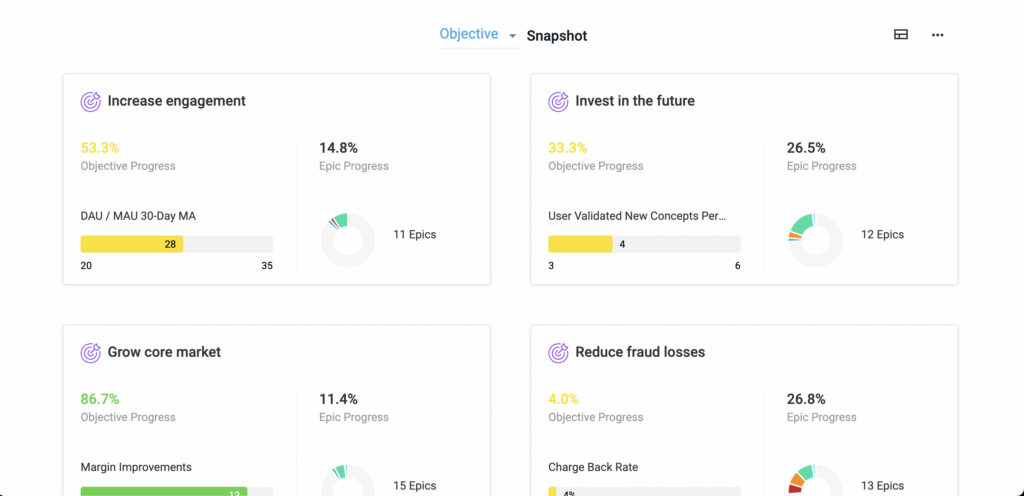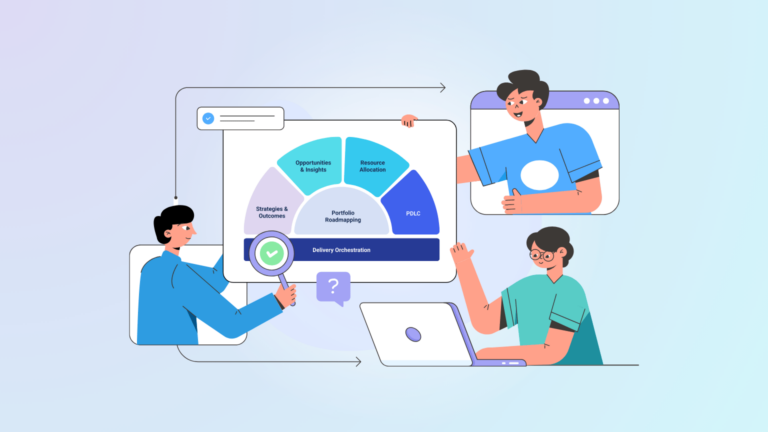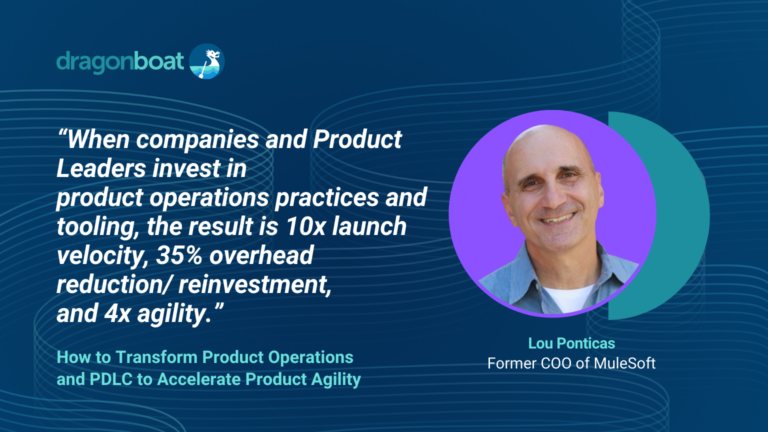If you are reading this, congratulations! You are already way ahead of “customer-focused” product teams that are operating from a giant catalog consisting of product >> component >> master feature >> feature. So – what is outcome-driven product management? How do you “escape the build trap”?
In this post, we explain outcome-driven product management, highlight four elements of being outcome-focused, review some of the benefits, and explain how individual roles in the product org can become more outcome-focused.
What’s the Definition of Outcome-Driven Product Management?
Outcome-driven product management is an approach for product-centric companies to bring to market and manage a product or portfolio of products that emphasize outcomes instead of outputs while facilitating top-down alignment, bottom-up innovation, and cross-team collaboration.
The baseline for outcome-driven organizations begins with setting clear goals. With established goals, you can then evaluate how to create the best solutions. Next, you can tie this strategy together and measure progress towards the desired outcomes.
Outputs vs. Outcomes
One of the common misconceptions about outcome-driven product management is that you either produce outcomes or outputs. However, it can’t be either or. Outputs are still a necessary means to an end for achieving outcomes.
This tweet by Jabe Bloom explains the relationship of outcomes vs. outputs perfectly: without successfully laying 10,000 bricks (output), you won’t end up with a house that becomes a home (outcome).
Output vs Outcome.
— Dr. Jabe Bloom (@cyetain) March 19, 2019
Output: 10,000 bricks and mortar.
Output: House built
Outcome: Family has a home. Children feel secure and safe.
the VALUE to the end user (the family) is not bricks…
OTOH… no bricks no house.
When it comes to outputs, outcome-driven teams distinguish between good and great ideas, delivering the right outputs or features that will create the most significant impact and ultimately lead to the greatest outcomes. They scrupulously prioritize and re-prioritize to prevent scope creep and stay focused.
Because outcome-driven teams focus on delivering the right thing, they measure success differently. As a result, celebrating outputs for their own sake becomes a thing of the past.
“Good teams celebrate when they achieve a significant impact to the business KPIs. Bad teams celebrate when they finally release something.”
Marty Cagan
What Sets Outcome-Driven Product Teams Apart?
Many teams strive to be outcome-focused, but how do you know if they are?
Here are 3 key elements that outcome-driven teams have in common:
1. Work to Achieve Three Types of Outcomes
Both feature-focused and outcome-focused teams work toward the desired customer and business outcome, but the latter works toward a third, the product portfolio outcome. This outcome is the holistic view for the entire product organization, between the near-term focus and long-term vision.
Outcome-driven product organizations take a portfolio approach even with a single product because it may serve multiple user groups, contribute to numerous goals, and require various teams to build it. Product teams must allocate resources responsively across multiple dimensions to drive the best portfolio outcomes. (More on that below!)
2. Tie Product Strategies to Company Goals
Alignment must occur vertically and horizontally across teams and functions in an outcome-driven organization. The executive team should set the company vision and goals due to its strategic planning. Outcome-driven product leaders then assess and define product strategies that achieve these goals. These strategies become their product goals and initiatives.
3. Allocate Resources to Goals
If you set a personal goal to run a marathon but don’t prioritize it by allocating time in your week to train, it becomes more like wishful thinking than a realistic objective. The same is true for organizational goals. Outcome-driven organizations understand the importance of allocating resources to goals to ensure progress will be made toward them.
Industry-leading companies that endure for decades make sure to balance their resource allocation between multiple dimensions, outcomes and timeframes. They apply the rock, pebble, and sand prioritization technique to best manage their product portfolio. In doing so, they can also move forward with their big, strategic bets that will allow them to continue to innovate and transform.
4. Continuously Evaluate Progress Towards Goals and Adjust Product Focus and Priority
Are you tracking “roadmap progress” and thinking it’s outcome progress?
If you are over-achieving in one goal and underperforming in another, shouldn’t your product priority adjust? Yes, indeed this is what outcome-driven product teams do!
Benefits of Outcome-Driven Product Management
Here are just 5 benefits of having a culture of outcome-driven thinking:
- Rally teams behind a company goal and shared vision instead of features that don’t explain “why.”
- Create clarity and incentivize effective cross-team collaboration.
- Escape the build trap/feature factory.
- Empower data-driven decision-making and iteration.
- Stay competitive and avoid being blindsided by new entrants who are disrupting the market.
How Can Each Role in the Product Org Be Outcome-Focused?
Chief Product Officer (CPO)
Outcome-driven Chief Product Officers take a responsive product portfolio management (Responsive PPM) approach to connect strategy and execution to define goals, align strategies, evaluate allocation based on what’s working, what’s not, and what needs to be adjusted. Using a responsive PPM platform like Dragonboat, they can easily guide teams and have visibility into what multiple product teams are working on, how everything ties back to the company goals, and see all the progress in real-time.
To truly empower teams, an outcome-driven CPO should set the strategic direction and product vision, orchestrate collaboration and goal sharing amongst teams and allow teams to contribute to their goals.

Product Operations
An outcome-driven product ops manager makes sure to play a highly strategic role for the benefit of the entire company. Product operations’ areas of responsibility enable a successful, outcome-focused product organization.
Since product ops aim to accelerate portfolio outcomes, this role should naturally help lead the transition from feature-focused to outcome-focused where needed. Product ops should gain the support of a change agent, such as the CPO, plan an agile rollout, and configure the right tool to create visibility and enable the cross-functional team.
Product Managers
Product managers looking to become more outcome-focused should focus on the “why” instead of the “what.”
Instead of finding solutions that solely meet the customer’s needs, outcome-driven product managers make sure what they build will also contribute to the business and portfolio outcomes. Fortunately, by doing so, they will be more likely to get the resources they need to deliver their roadmap.
To communicate how their roadmap will contribute to the company goals, product managers should switch from feature-based roadmaps to OKR roadmaps and then adopt an outcome-driven product workflow.
What does being outcome-focused mean to you? What are some other ways that product organizations could become more outcome-focused? Let us know on Twitter or follow us on LinkedIn for a steady stream of product-centric goodness.



